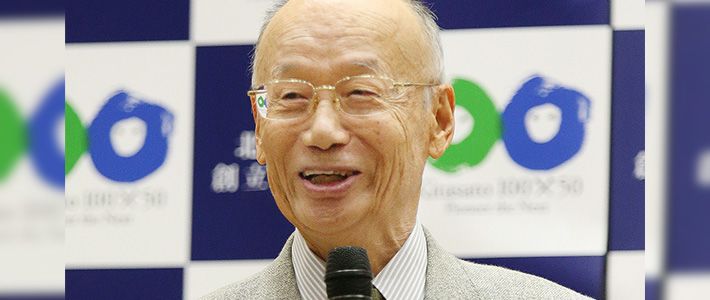
Ōmura Satoshi Wins Quarter Share of Medicine Nobel
Science Technology- English
- 日本語
- 简体字
- 繁體字
- Français
- Español
- العربية
- Русский
The 2015 Nobel Prize in Physiology or Medicine was awarded jointly to scientists from Japan, Ireland, and China for “therapies that have revolutionized the treatment of some of the most devastating parasitic diseases.” Ōmura Satoshi (professor emeritus at Kitasato University), William C. Campbell (research fellow emeritus at Drew University in the United States), and Tu Youyou (chief researcher at the China Academy of Chinese Medical Sciences) were announced as the winners in a statement at the Karolinska Institute in Stockholm on October 5, 2015.
The award for Ōmura follows the 2014 Physics Nobel for the invention of efficient blue light-emitting diodes to three Japanese scientists: Professor Akasaki Isamu of Meijō University, Professor Amano Hiroshi of Nagoya University, and Professor Nakamura Shūji (born in Japan, although now a US citizen) of the University of California, Santa Barbara.
Saving Hundreds of Millions of Lives
Ōmura has been gathering soil samples from various locations since the 1970s and taking microbes from them to cultivate and research whether the chemical substances they produce have useful properties. He discovered avermectin, which fights against the action of harmful microorganisms, from a new bacterium in soil from Shizuoka Prefecture. A team at the US pharmaceutical company Merck, including William C. Campbell, developed a derivative of the substance known as ivermectin, which has been dramatically effective in the treatment of river blindness and lymphatic filariasis as well as other parasitic diseases. Efforts by the World Health Organization to distribute ivermectin free of charge in sub-Saharan Africa, South Asia, and other areas where parasitic diseases are endemic have contributed to saving the lives of hundreds of millions of people every year. This valuable work jointly won Ōmura and Campbell their half of this year’s Nobel.
Tu Youyou, recipient of the other half of this year’s award, was recognized for her discovery of artemisinin, a drug that has dramatically improved survival rates for patients with malaria. She was originally assigned to research treatments for the disease in 1967, when Chinese leader Mao Zedong ordered her to work on an ailment that was then killing more North Vietnamese troops than the fighting of the Vietnam War. She found the clue that led to her discovery in an ancient text on traditional Chinese medicines.
In reference to all three of the prizewinners, the Nobel Foundation stated: “The global impact of their discoveries and the resulting benefit to mankind are immeasurable.”
The Microbes Did All the Work
Ōmura was born in 1935 in Yamanashi Prefecture. After graduating from the University of Yamanashi he taught at a night school while completing his doctorate at the Tokyo University of Science. He then worked at the University of Yamanashi and Kitasato Institute and studied at Wesleyan University in the United States before returning to Kitasato University in 1975 to become a professor. From 1990 to 2008, he was head of Kitasato Institute.
He has won numerous prizes, including the Gairdner Global Health Award. Following the Nobel announcement, at a Kitasato University press conference Ōmura modestly said: “It was the microbes that did all the work for me. I didn’t do anything great myself.”
Following Monday’s announcement, the total number of Japanese and Japan-born Nobel Prize winners has risen to 23. This includes ten winners for physics, seven for chemistry, three for physiology or medicine, two for literature, and one for peace. The first Japanese winner was Yukawa Hideki for physics in 1949.
(Originally written in Japanese and published on October 6, 2015. Banner photo: Ōmura Satoshi, professor emeritus at Kitasato University, smiles after the Nobel announcement on October 5, 2015. © Jiji.)